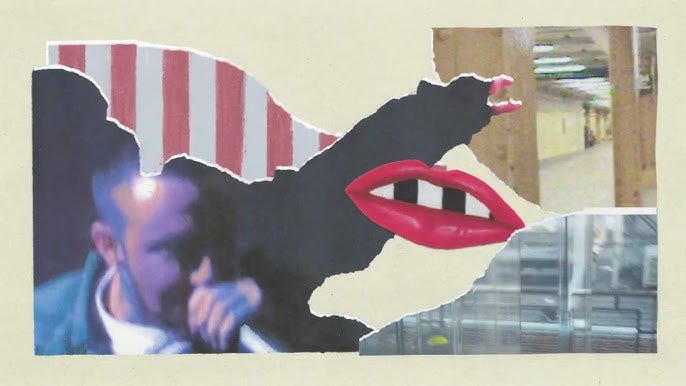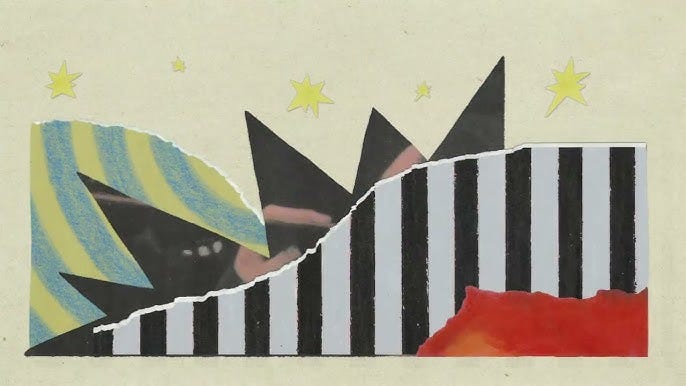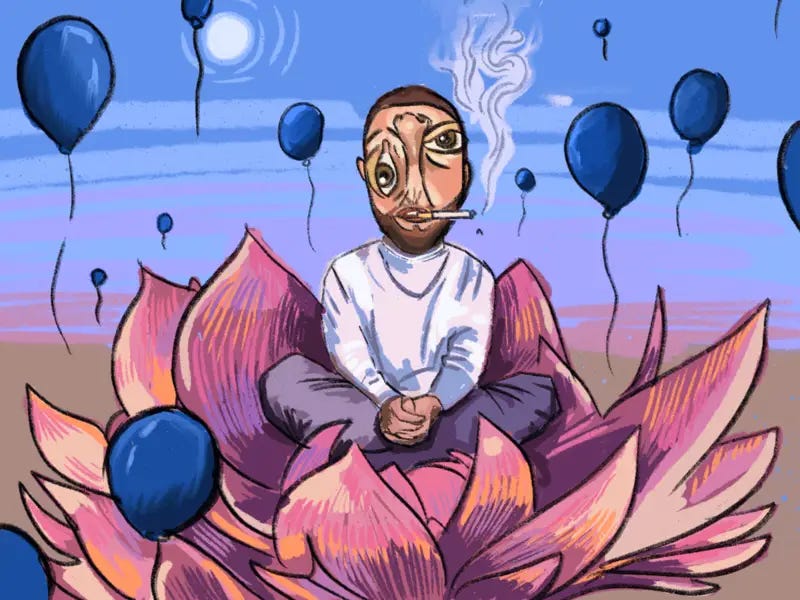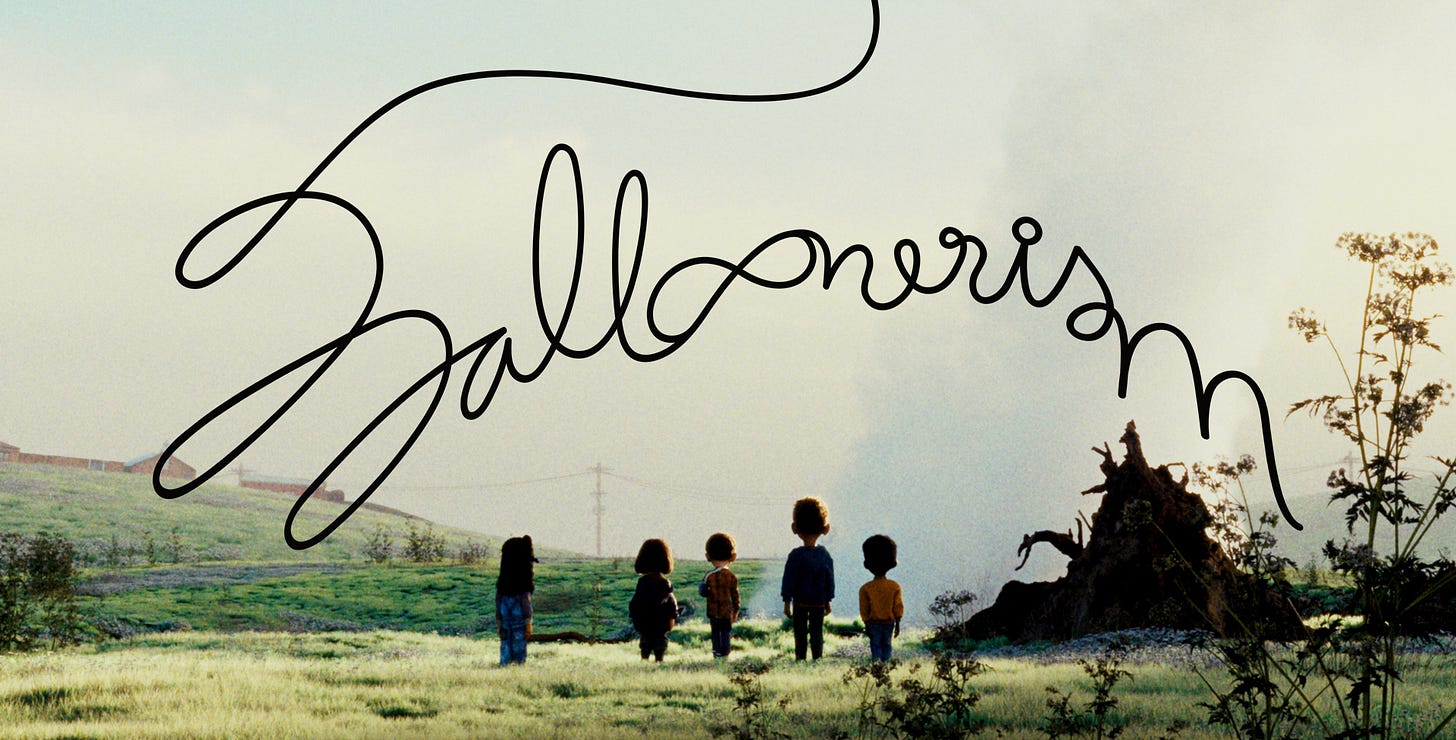Listen With Me: Balloonerism by Mac Miller
A deep dive into an otherworldly state of mind in Mac's latest Wonderland
It’s a cold, Monday morning at the office. Work updates are starting to trickle in, but I have ample time to grab a cup of mocha and peruse through my new emails.
On slower days like these, it’s the perfect time to put on an album and let yourself zone out for an hour of active, focused listening.
So I pressed play to Balloonerism, Mac Miller’s latest posthumous album, wanting to see what the hype was all about.
Track 1: Tambourine Dream
The album opens with an introduction that’s almost like a celebration of life. I’m reminded of the extravagant fiestas in Latin America, especially the Día de los Muertos.
In this context, the album already begins with an idea that’s more than music; it’s a celebration of Mac Miller’s life and the music he shared with the world. Now, we’re given a big slice of what remains.
Track 2: DJ’s Chord Organ (feat. SZA)
We’re in the recording studio, where a practice session is taking place as someone’s fingers wander over piano scales.
With every chord progression, the music becomes more dream-like, and the walls dissolve. Suddenly, like holding the string of a balloon, we’re lifted out of the studio, and into the blue, open sky.
It feels like the opening act of a musical on sunlit fields. A woman harmonises with herself and the harmonica, and it sounds like a choir of gospel angels singing in unison. Is this what soul heaven sounds like?
Then the first beat of the album enters. We hear a young SZA’s voice for the first time. A trumpet sound swells, like the balloon is being filled up. It grows to the size of a hot air balloon.
The synth ends with an ‘80s arcade melody, the kind that tells you that you completed a level. We’re no longer playing games — the real music begins now.
Track 3: Do You Have a Destination?
A voice we last heard from 2018 emerges from the synth and cymbals. Malcolm rises from the dead.
The balloon rises even higher. The melody is soft and unhurried, the piano not overstepping its spotlight, the beat steady. We’re reminded of who Mac is in relation to his constant life struggles.
The track ends with the title being repeated over and over. It’s clear that we’re moving— drifting forward rather than lingering in place — but the destination remains an open-ended question.
Track 4: 5 Dollar Pony Rides
The scene fades to a party. It’s about time Mac sings about something that talks and sounds happy and light-hearted.
Mac is upfront about his words – he talks about the temporality of this connection. But, he also displays a kind of tenderness, in that he’s capable of exploring a deeper emotional connection if OP is willing to.
And then I hear an outro that’s like a commercial break or elevator music of sorts. A 30-second intermission before we’re transported to our next location.
Track 5: Friendly Hallucinations
The party continues as we step into a jazz bar, but this one is unlike any other.
A lady appears, draped in the finest silk gown, but as the song unfolds, she descends into a flurry of ecstasy-infused mania.
Malcolm acts like the fallen angel on her shoulder, murmuring sweet, synth-laden words that pull her deeper into the music.
In my mind, blue and green spotlights flicker through the room. The scene pulses in slow motion, fading in and out every three seconds like those short-form video templates.
Track 6: Mrs. Deborah Downer
Somehow, we’ve been kicked out of the party and find ourselves standing by the garbage dump. In the distance, someone in a beret and tattered coat smokes a cigarette.
Sad electric piano riffs echo faintly in the background, as Mac reflects on his own struggles with drugs. There’s a sense of second-hand embarrassment, where he regrets having done his vices, yet he’s unsure how to move on from it.
This is Mac’s version of “de-influencing” his recovery phase, and probably gave us a glimpse of the imperfect life he lived, too.
Track 7: Stoned
Experimental blues take over the entire intro, and my ears perk up at the sound of the guitar.
We’re in an open convertible at a drive-in cinema. A black-and-white ‘50s movie flickers from the projector, but no one seems to be paying attention.
Mac quietly serenades our protagonist with lyrics far bleaker than the music, though. The vibes are too smooth to miss the darkness that OP is experiencing in this scene.
Track 8: Shangri-La
Still not getting bored of the synth. It’s always new and fresh – where is Mac taking us now?
I catch a bit of R&B woven into hip-hop beats, creating a mood that feels like the backstage of a concert dry run or a high-end fashion runway.
AV techs tinker with the mixer, testing the sound system while experimenting with offbeat originals that won’t make it to the final set. It mirrors how vanilla, unoriginal glamour often remains surface-deep, with everything else hidden, regardless of what the song title might suggest.
Track 9: Funny Papers
By the first lines of the verse, I’m floored. At this point, he’s been writing cryptic lyric after cryptic lyric, all tastefully incorporated at different points of the album.
Scarily accurate lyrics aside, this track feels like a 90s romance song. I’m now taken to a hotel lounge, where a grand piano rests on a stage surrounded by red velvet curtains.
Mac has a knack of making his music belong everywhere – they could belong to the streets, a luxury penthouse, and an art gallery at the same time, and this song is a great example of it.
After the bleak scenarios from the previous tracks, the piano outro feels like a much-needed reprieve, as Mac’s spirit floats around the lounge piano.
Track 10: Excelsior
There are kids screaming. The beat changes, and we’re taken to the streets of Brooklyn, perhaps to a much simpler life.
We’ll be hearing children’s voices throughout the rest of this album, which adds a chaotic innocence to Mac Miller's playful, child-like musical explorations. It’s giving 5th House priniciples in Western astrology, where creativity is often intertwined with tuning into your inner child.
As the song winds down, Mac chants like a kid casting spells, and we hear an unfiltered glimpse of his happier self. It’s nice to know that after all the tragic incidents in his life, we get to hear him have fun through his music again.
Track 11: Transformations (feat. Delusional Thomas)
We’re thrown back into the back doors of the jazz pub again. This time, Mac is experimenting on warped voices and white noise as the sound medium.
Remember Crazy Frog? Well, I didn’t know he had a collab with Mac with this one. 😂
Track 12: Manakins
I’m getting The Nutcracker vibes with this track. I’m now in a castle, and the guards are chanting a rock anthem for their falling / fallen king.
We’re reminded that beneath the whimsical charm of his music, life is not all rainbows and pastels – more often that not, we’re playing pretend in our oversized gowns.
Track 13: Rick’s Piano
“Wake Up.” Mac’s voice rings clear in the air. It’s time to leave Malcolm’s Wonderland.
The lightheartnedness of this track feels like we are down to our last stop in our hot air balloon trip, but before that, we’re treated to 5 minutes of musical nirvana – a blissful concoction of synths, melodies and voices unfolding like a flower blooming, both forward and in reverse.
“The best is yet to come” repeats like a mantra. It’s like a message from the grave, as our spiritual guide leaves us with parting words, both for ourselves in this life and for his in the afterlife.
It’s not a goodbye, but a see you again.
Track 14: Tomorrow Will Never Know
The voicemail, walkie-talkie-like sounds at the start is like a distant cry for help. The mood shifts to a psychedelic implosion, as the hot air balloon deflates, signalling the end of another creative journey.
About two minutes in, a high-pitched sound echoes periodically like a timer. It’s creating the harrowing experience of being rushed to the hospital from an ambulance. And yet, it doesn’t feel ominous — more like a strange, suspended state between this world and the next.
The sound of children’s laughter rings faintly in the background as the phrase “Do they feel just like we do?” repeats over and over. It is Mac’s final plea to stay alive — or perhaps, to keep his music alive — with whatever sober energy he has left.
The song drawls on, stripped down to just the hum of a bass guitar for a good, eleven minutes, leaving us to sit with the absence of the vibrant melodies that brought colour to the past thirteen tracks.
The guitar fades momentarily, replaced by the faint sound of a phone ringing and children screaming. Then, the bass guitar picks up one last time, like Mac experimenting with a riff before he lets go. The final notes are interrupted by a call that went unanswered, as life continues its noise.
It’s the haunting aftermath of creative potential cut short, removed from the face of the earth too soon.
The ending is open-ended. I’ve awoken from a dream, and it’s peacefully bittersweet. It’s not sad, there’s no hook — it’s just an experience that surrounds me, and feels easy to let go, knowing that it’s always there for you to receive it anytime again.
Unlike the drugs that eventually cost Mac Miller his life, the musical ecstasy from this album flows to your system like good, harmless energy, that neither takes nor delivers.
More than just a cautionary tale about not losing ourselves to unhealthy forms of escapism, Balloonerism serves as a deeply personal reminder and inspiration to push the boundaries of my creativity and imagination, and to inflate my own biggest balloon ever.
My mind wanders back to the present, and I get a ping from my boss. It’s time to return to reality, but with a renewed state of whimsy and wonder.
After all, the best is yet to come.
My personal favourites from the album:
I also shared my honest take on Balloonerism in my latest newsletter post over on Beehiiv. Read it here.
🐝 Looking for more music recommendations?
Sign up to my curated music newsletter at Beehiiv and receive fresh music discoveries every Wednesday. It’s a real vibe, no cap 😎









